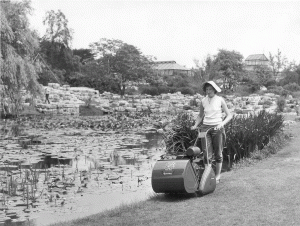
Since the 1950s the unprecedented expansion in technology has affected all aspects of our lives. Machines and new technologies have profoundly changed the way we work and view the world. Cambridge University Botanic Garden’s annual reports offer interesting insights into how machinery and technology were employed in the daily life and scientific processes of the Garden. For example, the Annual Report of the Botanic Garden Syndicate 1975-1976, notes the use of several different forms of machines or technology – from grass-cutters to scanning electron microscopes.

The Annual Report 1975 – 1976 provides an interesting snap-shot of the mid-1970s as it reflects a period of economic belt-tightening. In the case of grass-cutting, machines were helping to keep up standards, despite a lack of manpower. The Annual Report begins: ‘In spite of enforced economies, which are affecting the Botanic Garden like all University institutions, the reduced staff have succeeded in keeping up a high standard throughout the Garden and have even been able to initiate certain agreed developments in and around the Research Area…’ The report states that grass-cutting equipment had been ‘brought into use effectively to offset the inevitable and continuing decline in man-power’.
During this time the Garden initiated one of the first projects for the classification of the genus Geranium using computer-clustering. In the Annual Report of 1975-1976, the Garden’s Taxonomist, Dr Peter Yeo, said that ‘computer-printed descriptions were obtained’ and he hoped that Mr R J Pankhurst would soon produce a ‘computer-generated key’; once ‘minor factual amendments’ were overcome. Computers were introducing new possibilities of analyzing scientific data. At the same time they were producing new challenges as to how data was managed and programs prepared.

In the administration offices, typewriters and ‘Xeroxes’ were being used to prepare and circulate reports and scientific articles. We learn that draft copies of ‘A taxonomic revision of Euphrasia in Europe’, eventually to be published in the Botanical Journal of the Linnean Society (Volume 77, Issue 4, pages 223-334, December 1978), was being prepared ‘in typescript and is to be made available in ‘Xerox’ form to those interested’. The article was published on the Wiley Online Library on 28th June 2008, some thirty years after it appeared in print. ‘Xerox’ refers to an early form of photocopying (first introduced in 1959) rather than to laser printing (first introduced in 1969). In the mid-1970s, desk-top computers were at least a decade away as a common form of office equipment.

At the same time, in the laboratories, plant scientists and taxonomists were using a range of cutting-edge equipment, including scanning electron microscopes (SEM). Cambridge Instrument Company was a pioneer in the marketing of commercial SEMs in the mid-1960s. Garden research projects also included ‘tracer experiments using 14c and tritium’ and ‘newly discovered clones’ as well as cytological and taxonomic studies.
In 1976, Professor Sir Alan Rushton Battersby, Emeritus Professor of Organic Chemistry, Cambridge (1969 – 1992) concluded a long-term experimental project in the Garden into biosynthesis of natural products. The Annual Report says: ‘Under this project begun in 1969, the Garden has employed one extra gardener and an experimental glasshouse has been erected. The glasshouse now reverts, as agreed, to the Research Area use as a whole, as the property of the Garden. Professor Battersby thanked the Syndicate and staff of the Garden warmly for their cooperation, and was assured of the availability of limited facilities in the Research Area for any continuing or future work.’
Professor Battersby went on the receive a wide range of honours including a Royal Medal in 1984, the Wolf Prize in Chemistry in 1989, the Robert Alonzo Welch Foundation Lifetime Achievement Award – the Welch Award in Chemistry – and the Royal Society Copley Medal in 2000 for his work in plant genetics and biosynthetic pathways. He was knighted for his lifetime contributions to science in 1992.
This article originally appeared on the Connecting with Collections blog 2013.
What is a Botanic Garden? The Changing Role of the Garden, The Laboratory and the Garden, The Unbuilt Garden.
